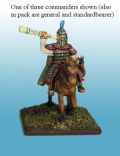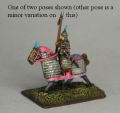Historical Overview Section
Western Wei from 540 to the end of the Tang in 763
The Western Wei started after the Northern Wei got split in two following a rebellion. The Eastern Wei don't get a list of their own. The Northern Zhou Dynasty followed the Western Wei, and ruled northern China from 557 to 581. Zhou Emperor Wu's death in 578 doomed the empire, as his son Emperor Xuan was an arbitrary and violent ruler whose unorthodox behavior greatly weakened the state. After Emperor Xuan's death in 580 his father-in-law Yang Jian seized power, and in 581 seized the throne from Emperor Xuan's son Emperor Jing (originally called Wendi), who had just crushed an army mutiny in the eastern provinces as prime minister of Zhou. Having won the support of the Confucian scholars that had powered previous Han dynasties Jing/Wendy initiated a series of reforms aimed at strengthening his empire for the war that would reunify China. In a campaign of southern conquest thousands of Sui boats confronted the naval forces of the Chen Dynasty on the Yangtze River. The largest of these ships were very tall, having five layered decks, the capacity of holding 800 passengers, and were outfitted with six 50-foot-long booms that were used to swing and damage enemy ships, or to pin them down so that Sui marine troops could use grapple-and-board techniques. But that's only possible in DBM really. Besides employing Xianbei and Chinese ethnicities for the fight against Chen, Wendi also employed the service of aborigines from southeastern Sichuan, peoples that Sui had recently conquered. In 588 CE, the Sui amassed 518,000 troops along the northern bank of the Yangtze River, stretching from Sichuan to the Pacific Ocean and took down the Chen Dynasty by 589 CE
The downfall of Sui Dynasty was a series of massive expeditions into the Goryego Three Kingdoms Korean Peninsula. The war that conscripted the most soldiers was caused by Sui Yangdi. The army was so enormous it was actually recorded in historical texts that it took 30 days for all the armies to exit their last rallying point near Shanhaiguan before invading Korea; in one instance, the soldiers—both conscripted and paid—listed over 3000 warships, 1.15 million infantry, 50,000 cavalry, 5000 artillery, and more. There were just as many supporting laborers, and an exorbitant military budget that included mounds of equipment and rations (most of which never reached the Chinese vanguard, as they were captured by Three Kingdoms Korean armies already). In all four main campaigns, the military conquest ended in failure. Nearly all the Chinese soldiers were defeated by the prominent army leader Eulji Mundeok of the Three Kingdoms Korean Goryeo. For example, of the 305,000 Chinese troops, only 2,700 returned to China, according to the Book of Tang records, soldiers in summer conquests would return several years later, barely living through the cold and famishing winter. Many died of frostbite and hunger
After these defeats and losses that the country was left in ruins and rebels soon took control of the government. Emperor Yang was assassinated in 618. Meanwhile, in the North, aristocrat Li Yuan held an uprising where he ended up ascending the throne to become Emperor Tang Gao Zu. This was the start of the next dynasty, Tang,
The Tang carried out successful military campaigns against the Later Horse Nomads. In the Sui Dynasty, Turks had become a major part of Chinese military forces and when the Later Horse Nomad Khitans began raiding northeast China in 605, a Chinese general led 20,000 Turks against them, distributing Khitan livestock and women to the Turks as a reward. While most of the Tang army was made of fubing Chinese conscripts, the majority of the troops led by Turkic generals were of non-Chinese origin, campaigning largely in the western frontier where the presence of fubing troops was low. Some "Turkic" troops were nomadisized Han Chinese. In 630, Tang armies captured areas of the Ordos Desert, modern-day Inner Mongolia province, and southern Mongolia from the Turks. After this military victory, Emperor Taizong won the title of Great Khan amongst the various Turks in the region who pledged their allegiance to him and the Chinese empire (with several thousand Turks traveling into China to live at Chang'an).
The Tang also had a punt at the Three Kingdoms Koreans and with an alliance between the Korean Silla and Tang armies, the Kingdom of Goguryeo was destroyed by 668. In 671 Silla began fighting the Tang and by 676, the Tang army was driven out of Korea by Unified Silla forces.
The Tang Empire fought with the Tibetan Empire for control of areas in Inner and Central Asia, which was at times settled with marriage alliances and at other times by war. There was a long string of conflicts with Tibet over territories in the Tarim Basin between 670-692 and in 763 the Tibetans even captured the capital of China, Chang'an, for fifteen days during the An Shi Rebellion which ultimately brought down the Tang Empire.
An Lushan was a half-Sogdian, half-Turk Tang commander with experience fighting the Khitans of Manchuria. After being given an army he used them to rebel, and named himself emperor of a new, but short-lived, Yan Dynasty. Despite early victories scored by Tang General Guo Ziyi (697-781), the newly recruited troops of the army at the capital were no match for An Lushan's die-hard frontier veterans. The Tang called upon the help of the Later Horse Nomad Uyghur Turks and the Abbasid Arabs to help put down An Lushan's rebellion, and the Tibetans took the opportunity to liberate large chunks of Tang territory in the confusion. Although An Lushan was killed by one of his eunuchs in 757 the time of troubles and widespread insurrection continued until rebel Shi Siming was killed by his own son in 763.
Using the army in FoG
- include your tactical tips or advice in here
- It looks neater if you do it with bullet points. Just put each new suggestion on a new line, starting with an "*"
UK Tournament Results with this army
Useful Links
User-contributed links about this army:
- Register and you can put you own link in here and then write some brief detail about the link here
- Register and you can put you own link in here and then write some brief detail about the link here
- put the link text readers will see in here write some more detail about the link here
Allies
Put information on allied contingents here - including recommendations on which to use, and why.
Painting and Collecting the Army
- Paintings from Cave 254 show Wei soldiers mostly in emerald blue but with some brick red. Cave 285 paintings show warriors in dark blue bordered in yellow or red bordered in yellow. Shields are red with yellow tops and sky blue bottoms or red with sky blue tops and bottoms or dark blue with sky blue tops and bottoms. The dark blue is almost black.
- Cavalry have metal or white cloth barding and wear dark blue or red clothing with light yellow surcoats. Cavalry have bow plus Lance but no shields.
- Most military figures in other caves wear primarily emerald blue clothing. The emerald part is faded. A slightly different blue shade is used to depict metal armor.
- Aurel Stein's notes depict a mounted standard bearer with an off white long tunic with vertical black stripes.
- Osprey 284 depicts mostly white with a fair amount of red and some mid to light purple
15mm Manufacturers supplying figures for this army
You can see some of the figures in the Ancients Photo Gallery also on this site. Have a look at the Mongol armies for suitable steppe nomad figures
|
|

|

|

|
- Essex Miniatures T'ang range
- Magister Militum fairly generic Han range
- Minifigs UK Tang range
- Irregular Minis (later) Sung CHinese
- Outpost Sui & Tang Chinese ranges
- Khurasan Steppe Nomads / Tribals & Tang
- Viking Forge Tang range
- Brial Hall’s Hall of Ancient Warriors Tang range
- Naismith & Roundway Similar-era Chinese and Khitans
Army Lists
Sample army lists for this army
Name of Army / Date
900 AP list used by Bob Medcraft and Peter Townshend at Usk 2010-01-30
- 1 skirmishers LF unprotected average drilled bow 6
- 2 Chinese light horse LH unprotected average drilled bow 4
- 3 Other professional infantry MF front rank protected average drilled light spear swordsmen 4
- 3 Other professional infantry MF rear rank protected average drilled bow swordsmen 4
- 4 Other professional infantry MF front rank protected average drilled light spear swordsmen 4
- 4 Other professional infantry MF rear rank protected average drilled bow swordsmen 4
- 5 Other professional infantry MF front rank protected average drilled light spear swordsmen 4
- 5 Other professional infantry MF rear rank protected average drilled bow swordsmen 4
- 6 Chinese light horse LH unprotected average drilled bow 4
- 7 Western Wei Heavy cavalry Cv armoured superior drilled lancer spearmen 4
- 8 Western Wei Heavy cavalry Cv armoured superior drilled lancer spearmen 4
- 9 Western Wei Heavy cavalry Cv armoured superior drilled lancer spearmen 4
- 10 Western Wei Heavy cavalry Cv armoured superior drilled lancer spearmen 4
- 11 Tribal auxiliaries LH unprotected average undrilled bow swordmen 4
- 12 Other professional infantry MF front rank protected average drilled light spear swordsmen 4
- 12 Other professional infantry MF rear rank protected average drilled bow swordsmen 4
- 13 Anti-cavalry squad HF protected average drilled heavy weapon 8
- 1 x IC, 3 x TC
Remember to leave a line before you copy the above section as a template for your own list
eBay Listings
UK Bookstore
| You can make the bookstore show only the books for the army you are setting up the page for. You need to change the line above where it says "node=0"by replacing the number "0" with the right code. You can find that by going to the Bookshop page, navigating to the right page, and holding your mouse over link to that army on the right hand menu. The node number you need to replace "0" with will show up in the bar at the bottom of your screen! Don't worry if you can't find it - I'll get round to sorting it out eventually |
